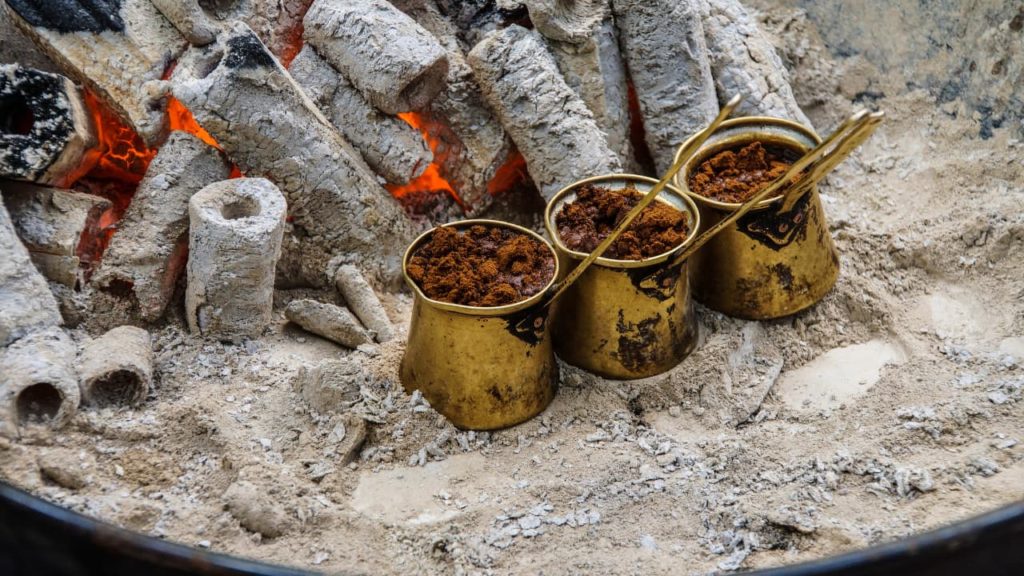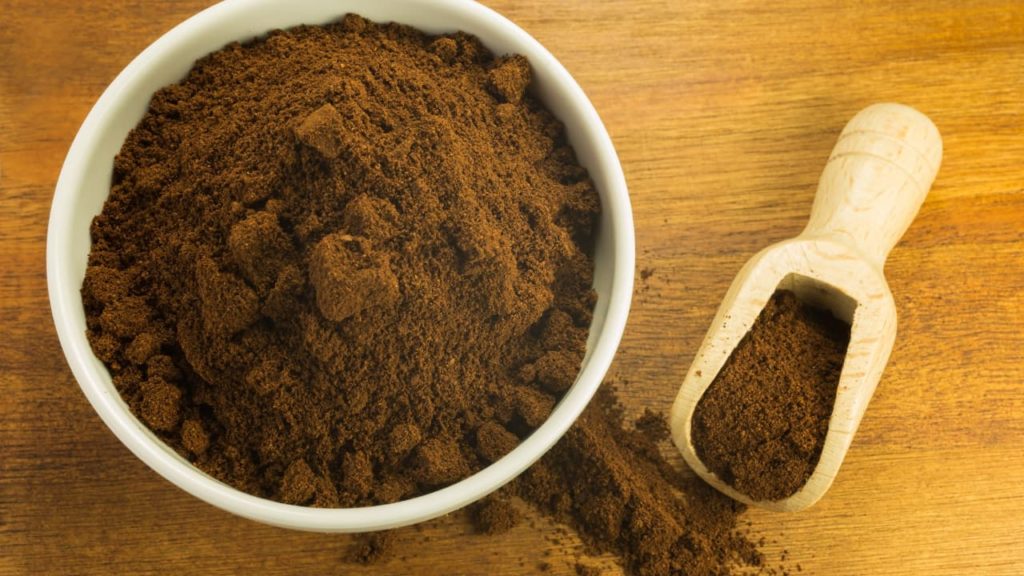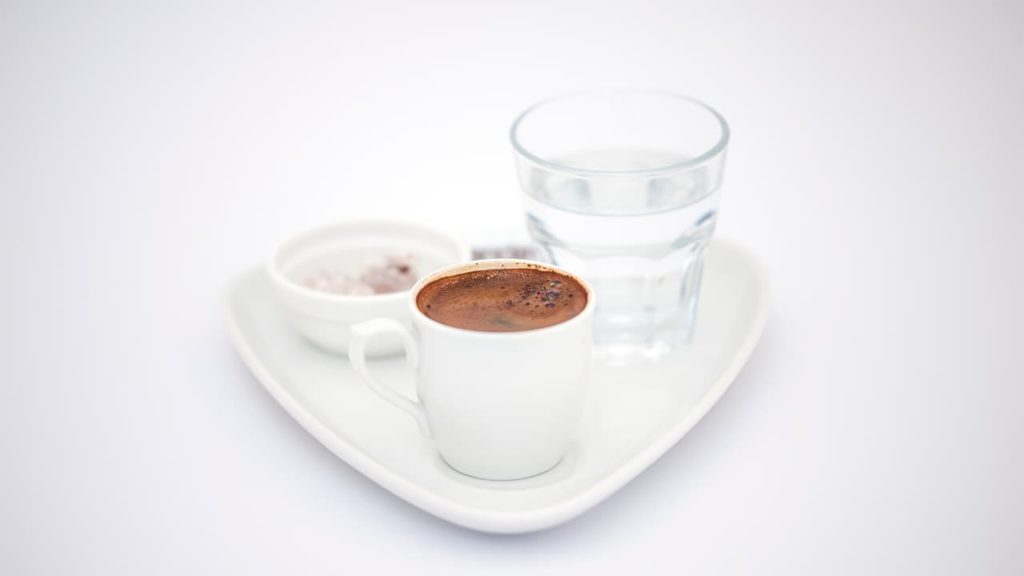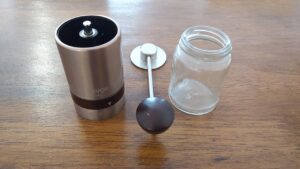
Turkish coffee is made with finely ground coffee beans and it’s typically served in small cups. The consistency is thick and creamy. The flavor is strong and it will leave you wanting more.
If you’re looking for an interesting and unique coffee to brew at home, then Turkish coffee is a perfect choice. Read on and find out how you can make this delicious beverage in a few simple steps.
What makes Turkish coffee different?
There’s no filtration system so the beans have to be ground finer than espresso. This way they can become waterlogged and settle down to the bottom.
While the process of making Turkish coffee is quite simple, it requires attention and some experience. One of the difficulties of this method is over-extraction. With extra fine grinds and high temperatures, it’s very easy to go overboard.
Is Turkish coffee bitter?
Turkish coffee has the reputation of being gritty, burnt and bitter. It happens because across the Mediterranean and Middle East people often overheat it and boil it many times. While this produces excess foam and it’s great for showing off and attracting tourists, it also causes over-extraction which leads to bitterness. That’s the main reason why they put loads of sugar and spices in traditionally prepared Turkish coffee – to compensate for the bitterness.

I’ve listed some factors that cause over-extraction:
- Bean density – Less dense coffee beans contain solids that dissolve readily in the water and have less tolerance to higher temperatures
- Roast level – Roasting reduces cellulose so a darker roast will promote extraction
- Too much agitation – Stirring coffee like a maniac, especially while it’s hot, will cause it to be bitter
- Brewing time – Too long contact with water results in more extraction
- High temperature – One way to prevent over-extraction is to use a lower temperature when brewing. This will slow down the extraction process and allow the coffee to develop a more complex flavor profile
- Boiling many times – Multiple exposures to high temperatures won’t do any good to the flavor
What kind of coffee is used for Turkish coffee?

Turkish coffee doesn’t mean any specific bean species. It’s a brewing method for which you can use any type of bean. My advice is to go for light to medium roasts and to use coffee grown at higher altitudes (above 1600 meters).
One distinctive treat of Turkish coffee is the extra fine grind. Finer than espresso. Almost powder-like. You can achieve this level of fineness with commercial-level grinders or hand grinders designed specifically for Turkish coffee.
The good thing is that you don’t need to spend a little fortune on a grinder capable of extra fine grinding. Reach out to your local coffee shop or roastery and ask them to grind it at the finest setting. (You can never go too fine with Turkish coffee.) The best taste and aromas are reserved for freshly ground coffee.
In the worst-case scenario, you can buy pre-ground coffee in a supermarket. (Did I say that?) Or order online. One way to test if the grounds are fresh is to grab them with your fingers. The pieces should not stick to one another and should crumble easily.
How to make Turkish coffee without cezve?
If you don’t have the Turkish coffee pot, called cezve, djezva or ibrik, you can get away with a smaller saucepan. It will do the work. But know that the brew won’t be foamy nor eye-catching as with cezve. Oh, and you might boil the coffee if you’re not careful (the rising foam in cezve signals when to stop brewing).
Turkish coffee recipe
The amount of water and coffee in this recipe is according to my preferences and specific pot size. You have to do your own adjusting according to what works better for you. I use one heaping teaspoon of coffee per cup. In my case, one teaspoon holds 7 grams which gives me a 1:10 coffee to water ratio. You can use a scale if you want to be consistent, but I usually skip it when making Turkish coffee.
Ingredients:
- Turkish coffee pot called cezve (or a saucepan) – I’m using a medium-size pot (300 ml)
- Water – 240 ml (enough for 3-4 cups)
- Extra fine coffee grounds – 22 grams (three heaping tablespoons)
- Sugar – optional
- Turkish coffee cups – one cup holds around two ounces of liquid
- Teaspoon
Before you start, you need to know the capacity of your pot, i.e. how many cups of coffee it can yield. Always use a pot suited to the amount of coffee you want to brew.
The traditional way of measuring water is by counting the cups. Use 1 or 1 ½ cup of water for 1 cup of coffee. The extra water is due to evaporation.
Steps
1. Add room temperature water to cezve. The level of water is based on the number of cups. But it should always be in the upper half of the pot and below the neck. If you’re using a saucepan, keep the water 1-2 inches below the top.
2. Put the coffee on the water surface. Use a teaspoon to add coffee but don’t stir. Let the grounds afloat.
3. Put cezve on the burner. Set heat to medium. Within the first minute, you can add sugar. Use one teaspoon per cup for regular sweetness, and two if you want extra sweet. Don’t stir yet.
My advice is to not add any sugar because it will hide all those beautiful aromas. You can always drink it with something sweet aside.
4. Observe the coffee. When the grounds sink, gently and briefly stir the coffee. As the coffee approaches boiling point, its surface will start expanding. At that moment you can lower the heat. When the foam starts rising, it’s time to turn off the burner and remove the pot from the heat.
Don’t let the coffee boils. Ever. Or you will burn it and lose the thick crema that enriches the coffee taste.
5. Pour coffee into the cups. The coffee is very hot at this moment, but immediate pouring helps the temperature to quickly drop below 90 degrees Celsius. This limits the time that coffee spends in the overheated range that causes over-extraction.
It’s still too hot to drink and the fine particles are flowing around the cup. Wait for the coffee to settle for 2-3 minutes.
Each cup should contain a nice thick layer of foam. A small cup size helps to keep the foam together. Though, by the time you start drinking it, it may already be gone.
6. Serve and drink. You can get creative with serving Turkish coffee. A good custom is to put a glass of water alongside to clean the palate before making the first sip. It’s also customary to have some sweets like Turkish delight or even sugar cubes, especially if you didn’t put any sugar in the brew.

What about boiling coffee many times?
Sometimes, you will see people remove the coffee from heat, spoon the foam out into the cups or pour coffee to the half of each cup, and bring the cezve back to heat. They repeat this 2-3 times, sometimes even more. While this can produce more foam, it can also burn your coffee and make it bitter. And the foam will disappear by the time it cools down to the temperature when you can drink it. Friendly advice – try to avoid this practice.

Tips for making Turkish coffee
- Buy fresh coffee whenever you can
- Don’t try to make it with regular ground coffee
- Always use the right size of a Turkish coffee pot for the amount of coffee you’re making. A pot that‘s too small will not hold the foam when it starts to expand and you’ll end up with spilled coffee. A pot that’s too big won’t make that nice foam. No foam means you won’t know when to remove the pot from the burner and you risk boiling the coffee
- Always brew on medium heat, never overheat or it will not turn rich and tasty
- Do not stir coffee if it’s close to a boil
- Don’t add sugar nor stir the coffee once you have poured it into cups. Otherwise, those fine coffee particles will flow around the cup instead of settling down at the bottom. It will also ruin the foam
- Instead of adding sugar afterward, consume the coffee with something sweet
- If some of your guests prefer no sugar, prepare and pour that cup first. Then return the coffee to the heat, add sugar to suit the remaining guests, and remove before it boils
- Never let the coffee boil (let alone successive boilings)
- Use scale for consisting brewing
Frequently Asked Questions
Can you have Turkish coffee with milk?
Some people like to add a little milk or cream to soften the coffee’s intense flavor, while others prefer to drink it black. Milk hides flavors, so if you’re looking to really taste the coffee’s nuances, it’s best to drink it black.
Is Turkish coffee just espresso?
Turkish coffee is not espresso. Espresso is made by pushing hot water under pressure through a compressed coffee puck in a short time period (around 30 seconds). Turkish coffee is made by heating the water mixed with coffee grounds without any filtering over longer time period (3-8 minutes, depends on the initial water temperature).
One ounce of the espresso shot contains 30-50 milligrams of caffeine. A cup with two ounces of Turkish coffee has around 65 milligrams of caffeine. In general, espresso contains a bit more caffeine than Turkish coffee per drop. Yet, if you boil Turkish coffee many times, more caffeine is extracted from the mixture of water and extremely fine grounds.
Is Turkish coffee stronger than regular coffee?
Turkish coffee is stronger than regular coffee.
Do you drink the sludge in Turkish coffee?
No, but you might drink it unintentionally.
Is Greek coffee the same as Turkish coffee?
Greek coffee and Turkish coffee mean the same thing. It depends on whom you ask and from where they come from. Different countries use different names for this coffee throughout the Mediterranean and Balkans region. For instance, it’s called Serbian coffee in Serbia, Bosnian coffee in Bosnia, etc.
Does Starbucks make Turkish coffee?
No, Starbucks does not make Turkish coffee.
Can I use regular coffee for Turkish coffee?
No, you cannot use regular coffee for Turkish coffee. Turkish coffee is brewed using very fine coffee grounds, and regular coffee grounds are too coarse for this type of brewing method.
What’s next?
Turkish coffee is a delicious and unique way to enjoy coffee. With these tips, you’ll be able to make a great cup of Turkish coffee at home. So grab your pot and get started!







